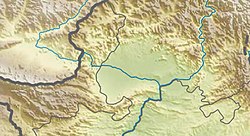 | |
| Coordinates | 34°21′58″N 70°28′08″E / 34.366041°N 70.468981°E |
|---|---|
| Type | Buddhist monastery |
| History | |
| Founded | 1st century BCE |
| Abandoned | 9th century CE |


Tapa Shotor, also Tape Shotor or Tapa-e-shotor ("Camel Hill"),[5] was a large Sarvastivadin monastery near Hadda, Afghanistan, and is now an archaeological site.[6] According to archaeologist Raymond Allchin, the site of Tapa Shotor suggests that the Greco-Buddhist art of Gandhara descended directly from the art of Hellenistic Bactria, as seen in Ai-Khanoum.[7]
In 1992 the Taliban looted and then set Tapa Shotor on fire.[1]
- ^ a b Cite error: The named reference
ZTSRH62was invoked but never defined (see the help page). - ^ "Tepe Shotor Tableau. Hadda, Nangarhar Province. ACKU Images System". ackuimages.photoshelter.com.
- ^ Behrendt, Kurt A. (2007). The Art of Gandhara in the Metropolitan Museum of Art. Metropolitan Museum of Art. ISBN 978-1-58839-224-4.
- ^ Boardman, George. The Greeks in Asia. pp. Greeks and their arts in India.
- ^ Vanleene, Alexandra. "The Geography of Gandhara Art" (PDF): 143.
{{cite journal}}: Cite journal requires|journal=(help) - ^ Vanleene, Alexandra. "The Geography of Gandhara Art" (PDF): 158.
{{cite journal}}: Cite journal requires|journal=(help) - ^ "Following discoveries at Ai-Khanum, excavations at Tapa Shotor, Hadda, produced evidence to indicate that Gandharan art descended directly from Hellenised Bactrian art. It is quite clear from the clay figure finds in particular , that either Bactrian artist from the north were placed at the service of Buddhism, or local artists, fully conversant with the style and traditions of Hellenistic art , were the creators of these art objects" in Allchin, Frank Raymond (1997). Gandharan Art in Context: East-west Exchanges at the Crossroads of Asia. Published for the Ancient India and Iran Trust, Cambridge by Regency Publications. p. 19. ISBN 9788186030486.


